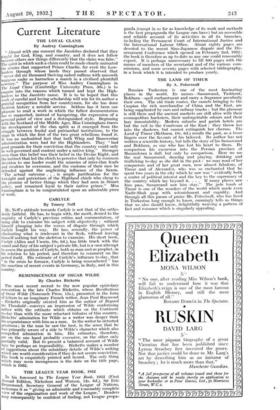Russian Turkestan is one of the most fascinating places in
the world. Its names—Samarcand, Tashkent, Bokhara—spell enchantment and carry a fragrance peculiarly their own. The old trade routes, the camels bringing to the Caspian the rich merchandise of China and the East, are being supplanted by cars and railway tracks : but the glamour is still there and the ancient markets are still alive with their cosmopolitan hucksters, their unforgettable odours and their lazy immutability. Modern suburbs and garish hotels are but the veil to the Courtesan of the East : they throw her into the shadows, but cannot extinguish her charms. The Land of Timur (Methuen, 10s. 6d.) recalls the past, as a lover lingers over the favours of his beloved. Its author has not written a scientific history, but tells the story of his Samarcand and Bokhara, as one who has lost his heart to them. By comparison his excursion into the Persian province of Mazanderan is dull, but only by comparison. Here we see the real Samarcand, dancing and playing, drinking and trafficking to-day as she did in the past : we may read of her conquerors and of her great men, now almost fabulous, of Timur and of Alexander, who was so enchanted that he spent two years in the city which he saw was " evidently both a centre of political interest and the key to the supremacy of the country which lay beyond it. . . . If many places saw him pass, Samarcand saw him stay." The jade tomb of Timur is one of the wonders of the world which made even Nadir-Shah gasp with astonishment and cupidity. And through all this paean of praise Mr. Polovtsoff, who has lived in Turkestan long enough to know, cunningly tells us things that we also should know, delightfully weaving a pattern of fact and romance which is singularly appealing.






























 Previous page
Previous page